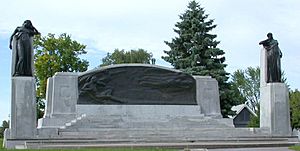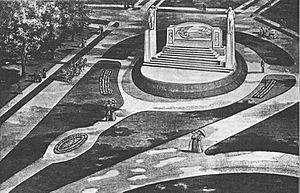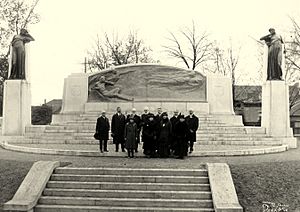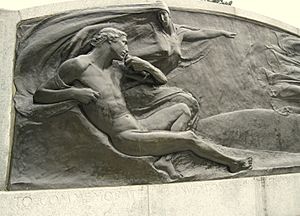Bell Memorial facts for kids
Quick facts for kids Bell Memorial |
|
|---|---|
| City of Brantford | |

The frontside of Bell Memorial
|
|
| For invention of the telephone | |
| Unveiled | 24 October 1917 |
| Location | 43°8′27.94″ N 80°16′4.88″ W near |
| Designed by | Walter Seymour Allward |
|
Commemorating the invention of the telephone at Brantford by Alexander Graham Bell in 1874
|
|
The Bell Memorial is a special monument in Brantford, Ontario, Canada. It was designed by Walter Seymour Allward. This memorial celebrates the amazing invention of the telephone by Alexander Graham Bell at his family home, the Bell Homestead National Historic Site. People also call it the Bell Monument or Telephone Monument.
In 1906, people from Brantford and Brant County created the Bell Telephone Memorial Association. This group decided to build the monument. By 1908, they asked artists from around the world to share their ideas. A Canadian artist named Walter Seymour Allward won the competition. The memorial was supposed to be ready by 1912. But Allward and his helper, Emanuel Hahn, finished it five years later. The Governor General of Canada, Victor Cavendish, 9th Duke of Devonshire, officially showed the memorial to the public on October 24, 1917.
Allward designed the monument to show how the telephone helps us talk across long distances. Steps lead up to the main part. Here, a figure called Inspiration floats above a man. This man, called Man, transmitting sound through space, is discovering how to send sounds far away. He points to three other floating figures: Knowledge, Joy, and Sorrow. These show the different messages we send. On the sides, two female figures stand on stone bases. They represent Humanity, one sending a message and the other receiving one.
The Bell Memorial is seen as one of Allward's best early artworks. It has been a main spot for many important events in Brantford. The memorial is a big part of the city's history. In 2005, it was named a heritage site under the Ontario Heritage Act. In 2009, it was added to the Canadian Register of Historic Places.
Contents
How the Telephone Was Invented
Alexander Graham Bell thought of the telephone's technical ideas in July 1874. He was living with his parents at their farm, Melville House, which is now a National Historic Site of Canada. One of the first successful long-distance voice calls happened on August 4, 1876. It was made between the telegraph office in Brantford and Bell's father's home. He later made the telephone even better in Brantford. Canada's first telephone factory was also in Brantford. It was started by James Cowherd and ran from 1879 to 1881. This is why Brantford is sometimes called The Telephone City.
Why Was the Bell Memorial Built?
People in Brantford first talked about building a monument in 1904. They wanted to honor Bell and his invention. The Bell Telephone Memorial Association officially started in 1906. Alexander Graham Bell himself approved of the idea. The association and the monument plan were publicly supported on March 9, 1906. This happened at a special dinner in Brantford that Bell attended.
Later that year, the association was officially set up by the Ontario Legislature. Their goal was to celebrate the invention of the telephone in Brantford. They also wanted to name Bell as the inventor. It was very unusual to build a big monument for someone who was still alive. This usually only happened for important leaders. But the monument honored both Bell and his invention. This focus on the invention likely convinced Bell, who was a modest person, to attend the unveiling.
Who Supported the Memorial Project?
Many important people supported the association. These included George, Prince of Wales (who later became King George V). Also, Gilbert Elliot-Murray-Kynynmound, 4th Earl of Minto, a former Governor-General of Canada, helped. His successor, Governor-General Albert Grey, 4th Earl Grey, also gave his support. About a dozen other leaders in Canada and the United States backed the project.
Donald Howard, 3rd Baron Strathcona and Mount Royal was the first honorary president. After he passed away, Prince Arthur, Duke of Connaught and Strathearn, another former Governor-General, took his place. William Foster Cockshutt, a local Member of Parliament, first suggested the memorial in 1904. He became the association's president. Another MP, Lloyd Harris, was the vice-president. The committee that chose the design was led by Byron Edmund Walker. He was a well-known Canadian banker and supporter of the arts.
The association quickly raised CA$35,000 in its first few months. By September 1909, they had $44,000. Eventually, they collected over $65,000 from people all over the world. The Canadian government also gave $10,000. Prime Minister Sir Wilfrid Laurier supported this contribution. Raising so much money was a big achievement for a city with only 30,000 people.
Choosing the Best Design
In 1908, invitations were sent to 22 artists in Europe, the United States, and Canada. They were asked to send in models for the monument. By May 1909, nine or ten models had been submitted. A special committee chose the three best designs. Then, three outside judges made the final decision. These judges were Sir Byron Edmund Walker, Senator George Allen Davis, and Sir George Christie Gibbons. All of them were known for supporting the arts.
They all agreed to choose Walter Seymour Allward. Sir Byron Walker, the wealthy banker, likely helped influence this choice. He had previously told a Brantford banker how good Allward's past work was. He said he wanted "the best possible outcome artistically" because it was a national project.
Why Was the Memorial Delayed?
Allward was chosen in 1908, and a contract was signed in 1909. The first cost estimate was $25,000, and it was supposed to be done by 1912. Also in 1909, the association bought Alexander Melville Bell's old farm, Melville House. They gave it to the City of Brantford to turn into a museum.
Allward had help from his assistant, Emanuel Otto Hahn. Hahn was also a very talented artist. He worked on the monument until 1912, when he left for the Ontario College of Art. The project went slowly because Allward was working on other big projects at the same time. One of these was the South African War Memorial in Toronto.
In April 1915, Allward told the committee that two large figures for the monument were ready. He also said that work on the foundation had begun. But he couldn't say when the main bronze part would be finished. This was going to be the largest bronze casting ever made in North America at that time. He wrote, "I am giving all my time to it; I cannot do more. It is an important panel and cannot be too well done." The memorial was not finished until 1917. This was due to World War I, a lack of materials, and problems with shipping.
Unveiling the Bell Memorial
The Brantford monument was finally shown to the public on October 24, 1917. It was a rainy day, but thousands of people came. The Governor General of Canada, Victor Cavendish, 9th Duke of Devonshire, officially unveiled it. He arrived by train with other important people. A children's choir, honor guards, and a band greeted them. The bells of Grace Anglican Church, near the memorial, also rang. Chief A.R. Hill of the Six Nations Tribes of the Grand River was also there. Bell had been made an honorary tribal chief by the Six Nations.
The city declared a public holiday for the unveiling. All normal activities were stopped for the day. After the Governor-General spoke and unveiled the monument, many people moved indoors. They went to the city's Old Opera House because of the rain. The ceremonies continued inside. Bell spoke to the audience twice more. He spoke at the opera house and again at a formal dinner. Other important people also spoke with Bell. These included J.A.D. McCurdy from the Aerial Experiment Association. Also, Gilbert Grosvenor, president of the National Geographic Society, was there.
Alexander Graham Bell reminded everyone that "Brantford is right in claiming the invention of the telephone here." He said it was "conceived in Brantford in 1874 and born in Boston in 1875." He also gave the Duke a silver telephone. Bell hoped the Duke would remember that the telephone started in Brantford. He also mentioned that the first long-distance call was between Brantford and Paris. Bell's wife, Mabel Hubbard Bell, gave $500 to the city. This money helped support soldiers fighting in Europe.
What the Memorial Looks Like
When it was unveiled, the Bell Memorial was one of Canada's most impressive monuments. It was designed to show how the telephone "wipes out" long distances on Earth. The figures on the monument represent different ways the telephone is used worldwide. Its most striking part is a large bronze panel. It is about seven and a half meters wide and two and a half meters high. This panel shows Inspiration whispering to Man. It shows him discovering his power to send sound through space.
Three ghostly figures, Knowledge, Joy, and Sorrow, are also on the panel. They show the messages sent by telephone. Two large female figures stand on either side of the steps leading to the monument. They represent humanity. One is sending a message, and the other is receiving one. The two female figures are placed far apart. This shows the telephone's ability to connect people over great distances. A curved line on the bronze panel connects everything. It shows the telephone's use all over the world.
The Memorial is located in the Bell Memorial Gardens. This is part of Bell Memorial Park at 41 West Street in Brantford. The monument itself is on a triangular piece of land that is a public park. This area, with its green lawns and artistic design, is called the Bell Memorial Gardens.
The Model for "Man"
The person who posed for the figure of Man, discovering his power to transmit sound through space was Cyril William George Kinsella. He was a wounded soldier from Brantford. Kinsella was badly hurt in the war in Europe. He became Allward's model for the figure of Man. Kinsella was born in the UK. He was one of about 100,000 disadvantaged British children sent to Canada. These "Home Children" came in the late 1800s and early 1900s to find better lives.
After arriving in Ontario in 1908, he lived in several Fegan Homes. He likely met Allward in Toronto. Kinsella eventually settled in Brantford County to work on a farm. In 1914, even though he was underage, he was tall and healthy. He joined Brantford's 125th Battalion to fight overseas. He fought in Belgium and France during World War I.
Kinsella was wounded and suffered from shell shock at the Second Battle of Ypres in Belgium. He was sent back to Canada in 1916. While recovering, he met Allward in Toronto and worked as his model. He later said, "The posing was exacting and took about two months." Kinsella got bored with civilian life and rejoined the Canadian Army. He went back to Europe. He was serving near St. Marie Chappell in France when the memorial was unveiled in Brantford. He returned to Canada after the war. But he didn't see himself on the memorial until 27 years later, in May 1946.
Other Parts of the Monument
At the top of the memorial are steps leading to the main part. This is a large piece of white Stanstead granite. On its front is the biggest single bronze casting made up to that time. This casting was so big it pushed the foundry's limits. The artist wanted to show how man discovered his power to send sound through space. Above the man is Inspiration, encouraging him. At the other end of the panel are Knowledge, Joy, and Sorrow, sent to man by telephone.
On both sides of the main monument are two "heroic" female figures made of bronze. They stand on granite bases. One is sending a message, and the other is receiving one by telephone. These two figures are placed far apart to show how the telephone can connect people over long distances. The curved line on the bronze casting connects the whole artwork. It shows how the telephone is used worldwide. Allward's first design also included flags of the world's greatest nations. This modern idea was probably left out so it wouldn't take away from the monument's classic design.
The back of the monument has a small stone base with bullfrog gargoyles. Carved into the stone are symbols of the British Crown and the Maple Leaf. A bronze plaque was also placed on the back. It listed the names of the people who supported the project. Today, this plaque is on the side of the rightmost granite base. The base, steps, and walls are made of strong Stanstead granite.
On the main part, two round panels are carved with Latin phrases. One says: "Hoc Opus Machinae Patri Dedicatum Est" (This monument has been dedicated to the inventor of the machine). The other says: "Mundus Telephonici Usu Recreatus Est." (The world has been recreated using the telephone). Below the central bronze casting is a large carved message: "To commemorate the invention of the telephone by Alexander Graham Bell in Brantford 1874." When it was first shown, the Bell Memorial caused some discussion because of its artistic and symbolic figures.
See also
- Alexander Graham Bell honors and tributes
- Alexander Graham Bell National Historic Site, Baddeck, Cape Breton, Nova Scotia
- Spirit of Communication, a statue and symbol of AT&T
- Thomas Cowherd, who helped start Canada's first telephone factory
Images for kids










